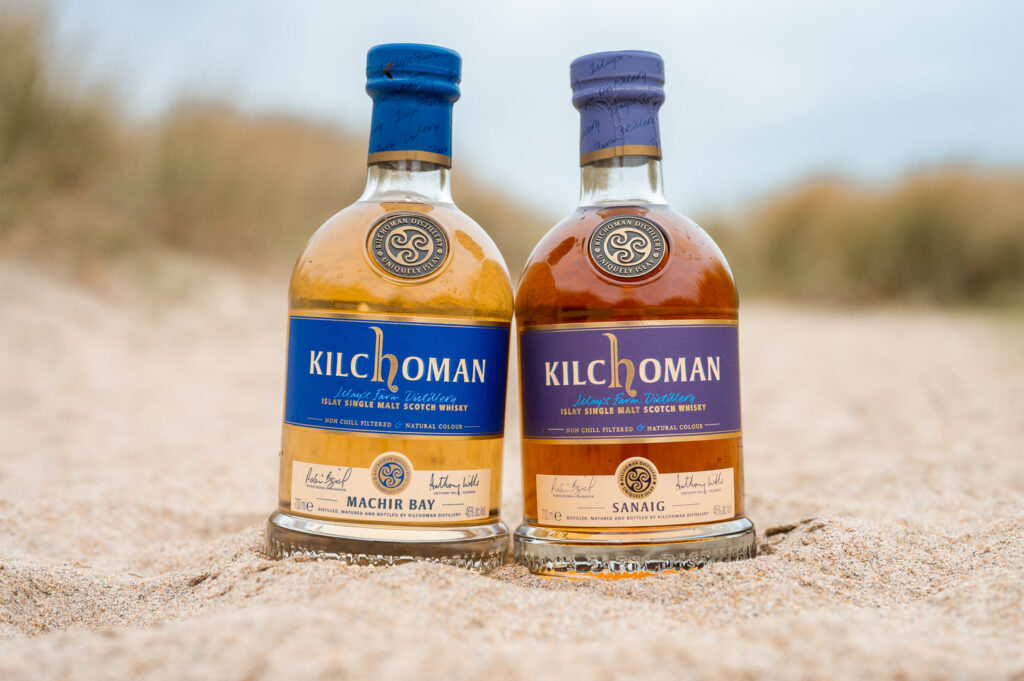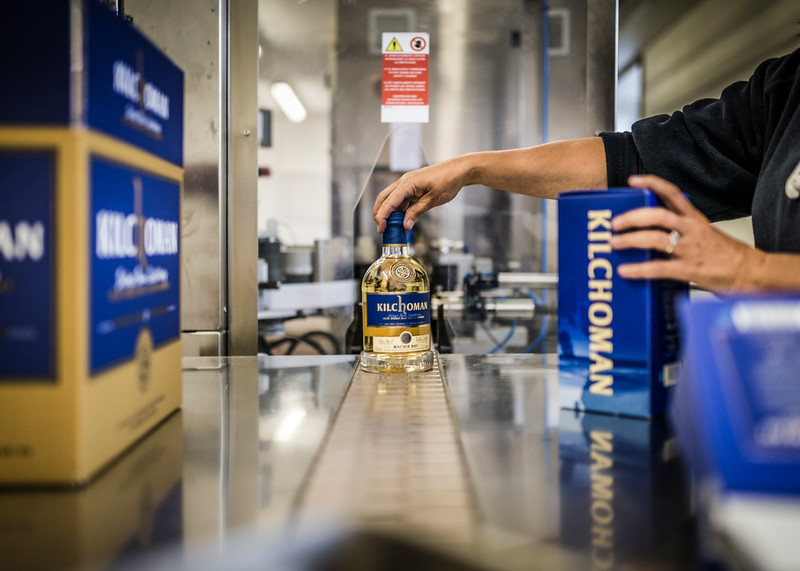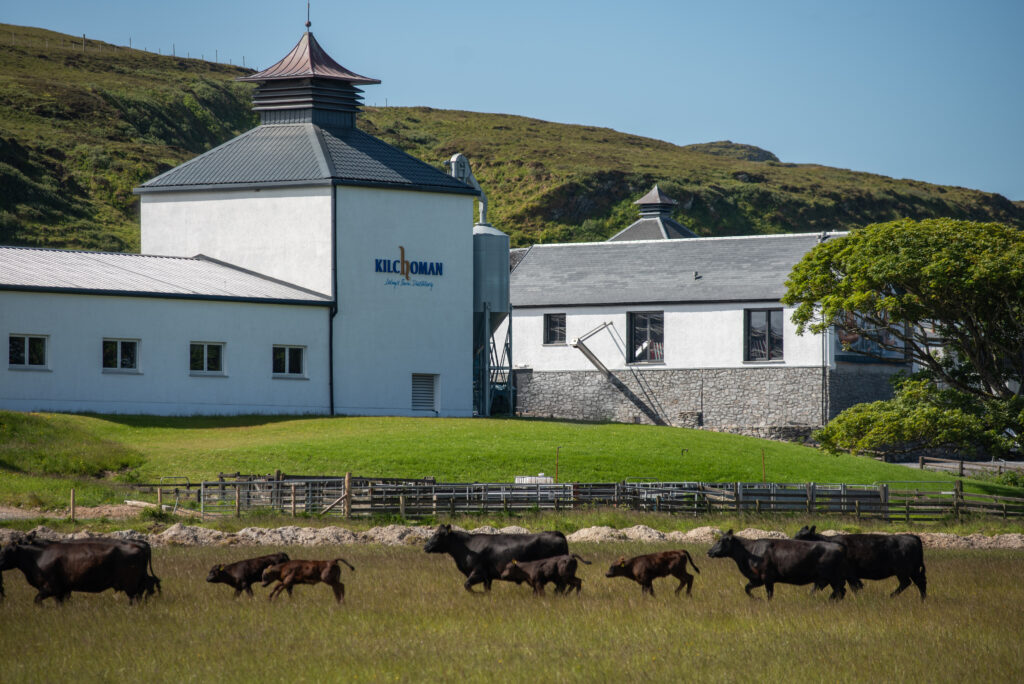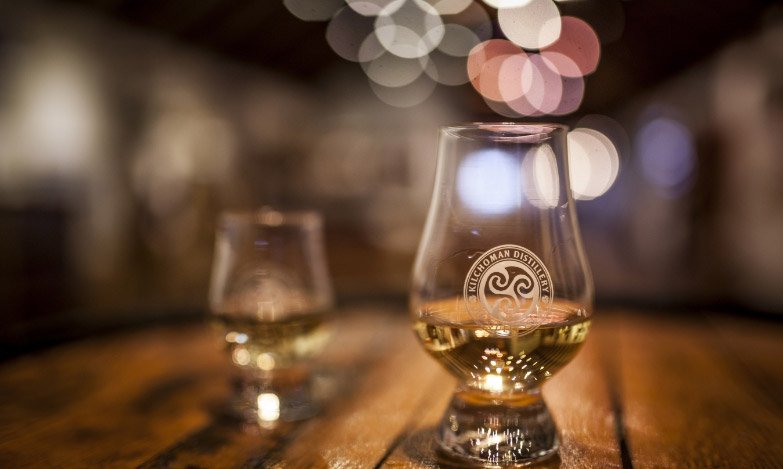BLOG POST, Featured
What exactly makes a scotch ‘single malt’, ‘single grain’ or a ‘blend’?
February 1, 2023Whisky is a complex spirit. The array of different classifications and rules that each type of whisky must satisfy means that no two bottles are ever the same. Previously, we have explored the differences between scotch and bourbon, but this time we will be diving deeper into the differing forms in which scotch can come. Scotch whisky can come as a single malt, a single grain and most commonly as a blend. These can often be confusing, and so in this post we will outline what exactly makes a scotch ‘single malt’, ‘single grain’ or a ‘blend’.
Single Malt
Here at Kilchoman Distillery we produce a Single Malt Scotch Whisky. The first step in understanding the term ‘single malt’ is to establish which part of the whisky making process each word of the term applies to. Firstly, let’s look at the term ‘single’. This is the most confusing part of the term, as it could apply to a variety of whisky related factors. For example, a common misconception for single malt whisky is that the word ‘single’ means that the whisky must be the product of a single batch, or a single barrel, of whisky.
However, this is not the case. In fact, almost all single malt scotch whiskies are blends. When we say ‘blend’, we are referring to the process of combining whisky from different casks and of varying ages together to form the final product. Different casks impart flavours into the whisky in different ways, and so distilleries blend whisky together to find a balance of flavours to form their single malt.
If the word ‘single’ doesn’t refer to the barrel or the batch, then what does it refer to? The ‘single’ in ‘single malt’ simply means that the whisky is the product of a single distillery. Therefore, while a single malt can contain whisky from many different casks, all of this whisky must have been produced by one distillery. For example at Kilchoman we often marry casks together, our Machir Bay and Sanaig are marriages of both ex-bourbon and ex-sherry casks and we are a single farm, single malt distillery.

Next, let’s look at the term ‘malt’ and what grain whisky is made from. This is the less confusing of the two, as there isn’t much else this word could refer to other than the grain that is used to make the whisky. In the case of single malt, this grain is exclusively barley – At Kilchoman we grow over 200 tons of barley on the farm then steep this for two days, adding room temperature water, which causes the grains to start to germinate. While large drums are now often used for malting barley, we use the traditional floor malting technique to prepare our barley for the next stages of the whisky-making process. After 5 days of germination we will then lift the malt from the floor and ‘peat’ our barley for 10 hours, this then creates our distinctive Kilchoman peat smoke aroma. The ‘malt’ in ‘single malt’, therefore, refers to the fact that the whisky must only be produced from malted barley and water.
Single Grain
While this term can be easily confused with ‘single malt’ due to its similarity, it is important not to get the two confused as they are quite different. One factor they do have in common is that the ‘single’ in both terms refers to the ruling that each whisky must be produced at a single distillery. However, the main difference is that single grain whiskies do not have to be produced from malted barley. In fact, other cereals such as wheat, corn or rye could all be used, and they can be malted or un-malted. As a result, single grain whiskies are usually light bodied and tend to offer sweeter notes over smoky aromas.
Single grain whiskies also differ from single malts in how they are distilled. Single malts are distilled using traditional pot stills, while single grains are distilled in column stills (or Coffey stills). Pot stills operate on a batch by batch basis and are used primarily for creating a flavourful product. On the other hand, column stills can be used to produce whisky of a high ABV on a more industrial scale. Therefore, single grain whiskies aren’t usually bottled alone (with a few exceptions) but are commonly blended with malts to create blended scotch whisky.
Blended Scotch Whisky
As we mentioned earlier, different whiskies are often blended together. The need for blending arose because, at the time, single malt scotch had a very strong and raw flavour that not everyone enjoyed. Through blending, Usher was able to create a scotch that had a milder flavour and appealed to a wider market. Today, about nine out of every 10 bottles of scotch sold worldwide are sold as ‘blended scotch whisky’. Pre-2009, any mix of scotch whiskies could qualify as a blended scotch. However, the Scotch Whisky Regulations now state that blended scotch whisky has to contain a combination of one or more single malt scotch whiskies and one or more single grain scotch whiskies.
The ratio of grain to malt in the blend varies from bottle to bottle. The grain forms the body of the whisky, while the malt gives the whisky additional flavours. As a result, more expensive blended scotch whiskies will tend to use a higher percentage of malt in their blend.
Alongside this new legislation came two new blended whisky categories: ‘blended malt scotch whisky’ and ‘blended grain scotch whisky’. While ‘blended scotch whisky’ previously encompassed all of these terms, the change to what exactly defined a blended scotch whisky required these two new classifications to be introduced. Blended malt scotch whisky means that it has been made from a blend of two or more single malt scotch whiskies from different distilleries. Similarly, a blended grain scotch whisky is the blend of two or more single grain scotch whiskies from different distilleries. Blended malt scotch is the more common of the two, however there are a few distilleries who sell blended grain scotch for the truly curious whisky connoisseurs out there.

So, to summarise –
Single Malt Scotch:
- Scottish whisky produced by a single distillery.
- Can only be made using barley and water.
Single Grain Scotch:
- Scottish whisky produced by a single distillery.
- Can be made using any cereal, including wheat, corn or rye.
Blended Whiskies:
- Blended Scotch Whisky – a blend of one or more single malt scotch whiskies with one or more single grain scotch whiskies from different distilleries.
- Blended Malt Whisky – a blend of two or more single malt scotch whiskies from different distilleries.
- Blended Grain Whisky – a blend of two or more single grain scotch whiskies from different distilleries.
We appreciate that all of the terminology surrounding whisky can get pretty confusing. Hopefully this crash course has given you a better understanding of the different varieties of scotch whisky available on the market. Here at Kilchoman, we specialise in crafting the finest single malt scotch whisky that Islay has to offer!
Click here to sign up to our Club and find out more about what we do at Kilchoman, Islay’s Farm Distillery

READ NEXT
BLOG POST
Fèis Ìle 2024
The countdown is on for Fèis Ìle 2024 and we’re looking forward to another great day. Save the date – Thursday 30th May 2024. We have been busy selecting a range of special drams and cask samples for the masterclass events as well as planning various tours, activities, live music…
April 9, 2024

